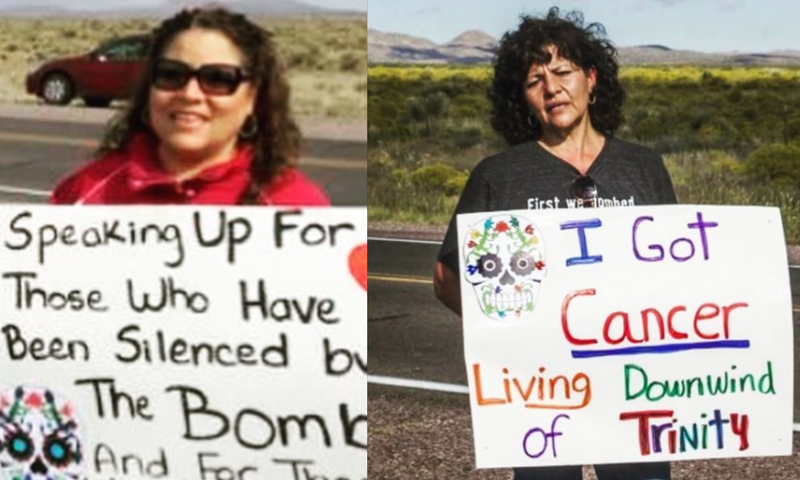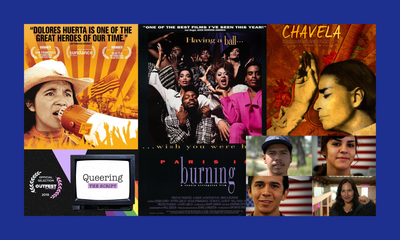Christopher Nolan’s three-hour movie Oppenheimer either held your interest or put you to sleep, but what it didn’t do is address the displacement and harsh reality of the Indigenous and Mexican-American communities that were downwind from the Trinity site in New Mexico on July 16, 1945. Yes, there is a whole side of U.S. history involving Mexican-Americans unaware they were exposed to high levels of radiation with increased risk of cancers after the Atomic bomb fallout that was not mentioned for one second in the movie.
The people of New Mexico would later be known as the “Downwinders” because the wind carried radiation that caused diseases such as cancer and birth defects to the majority of the towns of Carrizozo and Tularosa, much of the city of Alamogordo, and parts of the Mescalero Apache Reservation. The larger cities of Albuquerque to the north and El Paso to the south were each less than 200 miles away from the Trinity testing site.
Recently, a tweet by best-selling novelist and scriptwriter Alisa Lynn Valdés (formerly Valdés-Rodriguez) went viral.
Can't wait for the Oppenheimer buzz to die. The bomb those men built? They dropped in on New Mexico to test it. On my mother. She was 18 months old, in the fallout zone. Of the 21 girls in her high school class, 17 had leukemia. Tell THAT fucking story, Hollywood.
— Alisa Valdes-Rodriguez, M.S. (@AlisaValdesRod1) July 20, 2023
Alisa Lynn Valdés' Tweet
She impassionately wrote that the Atomic bomb was dropped on her then 18-month old mother who was in the fallout zone in Bosque near the town of Belen, New Mexico. She scolded Hollywood by mentioning how out of the 21 teen girls who went to high school with her mother, 17 had Leukemia and ended the tweet with “Tell THAT f—king story, Hollywood!”.
The movie, an adaptation of the 2005 novel American Prometheus by Kai Bird and Martin J. Sherrwin, broke records at the box office to every movie executive’s dream. The success of Oppenheimer which opened the same weekend as Barbie drove thousands to the theaters in what became paradoxically known as the “Barbenheimer”.
What many failed to realize is we are well into the summer of 2023 and generational families affected by the Atomic bomb fallout are still fighting the U.S. government for compensation. NPR’s “All Things Considered” story in July 2023 interviewed Paul Pino an indigenous ranch owner whose family has lived in Carrizozo since the late 1800s. He describes what his family saw when the Atomic bomb exploded. He said right after the bomb’s radioactive fallout small children came out to play in what they thought was “snow in July” and caught radioactive ashes on their tongue. As the radiation contaminated the air, water and soil it also infiltrated the crops harvested, the cattle butchered to eat and the water collected to drink in cisterns or underground wells.
The 2020 National Institutes of Cancer report found land at the Trinity test fallout zone tested for high radioactive material through the 1980s. That's roughly more than 40 years after the Atomic bomb test done at Los Alamos National Laboratory led by Oppenheimer. It also read that “there is great uncertainty in the estimates of radiation doses and number of cancer cases possibly attributable to the [Trinity] test, thus no firm estimates can be established.”
Since the fallout Valdés mother has suffered from thyroid cancer and a large brain tumor which she explained has tertiary effects on Downwinder families which people hardly talk about. Tertiary effects of the fallout were her Mom’s personality changed because the brain tumor affected her brain’s regulation. Other tertiary effects were “ripping her family apart” because of medical bill debt which changed their socioeconomic status but also their familial dynamic changed when her parents separated.
“He [Oppenhiemer] deliberately chose to detonate it on human beings who were United States citizens when he was given the choice to do it in Tennessee or doing it in New Mexico he chose here because there were fewer white people,” Valdés told BoldLatina about the racial motives behind the Atomic bomb testing.
“This was all very deliberate and very racist so to gloss over it is unacceptable white-washing of history– it’s saying some people are more important than others and serves a narrative of him that is heroic.”
Nolan’s film depicts that no one was inhabiting the surrounding rural areas of the Trinity testing site or its 150-mile radius or the Los Alamos National Laboratory but decades and records found later show that is historically incorrect.
It is said when the site of the Atomic bomb testing was chosen because there were only “Indians, cows and Mexicans”. That's what Latinos and the Indigenous were then to Oppenheimer and his laboratory team. In the 1940 census it recorded 121 people living within 20 miles and 13,000 people 50 miles from the Trinity site. The census is proof that civilians lived within the 150-mile radius of the Trinity testing site which contradicts government officials statements.
Downwinders including lifelong activist, seventh generation New Mexican and founder of Tularosa Basin Downwinders Consortium (TBDC) Tina Cordova reached out to director Nolan to meet back in 2021 when the movie’s production started with no interest to meet with Cordova. Although times were different in 1940 with segregation, movie director Nolan had a chance to use their worldwide success and platform to address this untold story.
“There are some glaring omissions,” Cordova told the Los Angeles Times’s De Los about the movie. “There was a level of racism, obviously [to the Manhattan Project]. They so easily invaded our lands, our lives, and destroyed them both.”
As history proves the U.S. is infamous for ignoring, omitting, or even erasing Latinx narratives and stories from their “American” history.
Just like Latina Valdés, Cordova’s family has been inflicted with cancer from the radioactive fallout for generations. Cordova’s grandparents lived 45 miles from the Trinity site where her family has experienced great loss with her father, Aunt, Grandmother, and Sister-in-law dying due cancer or related diseases. She has now seen cancer up to four generations in her family including Cordova recovering from thyroid cancer and her 23-year-old niece having it too.
TBDC and Cordova have fought to bring justice and compensation to Downwinders and their families after 78 years of the Atomic bomb test.
Radiation Exposure Compensation Act (RECA) is a one-time U.S. government lump-sum payment to people affected by the fallout of the Trinity testing including those working to mine uranium in three categories. One is that Uranium workers get $100,000, on-site Trinity workers at the laboratory get $75,000 with the lowest amount going to families in the surrounding areas or the Downwinders with $50,000.
The U.S. Senate recently passed an amendment to the National Defense Authorization Act (NDAA) that will greatly expand who can benefit from the RECA that includes, for the first time, New Mexico Downwinders and post-1971 Uranium miners. Cordova and the TBDC still have a long fight with RECA set to expire permanently in July 2024.
“I think film is the most powerful medium for artistic portrayal of anything,” Valdés explained to BoldLatina the importance of getting it right in Hollywood. “There’s some responsibility I think if you are making a historical biopic to be somewhat meticulous about researching the thing you are talking about to make sure it is fair.”






